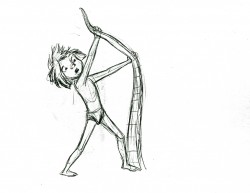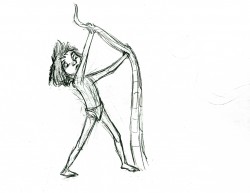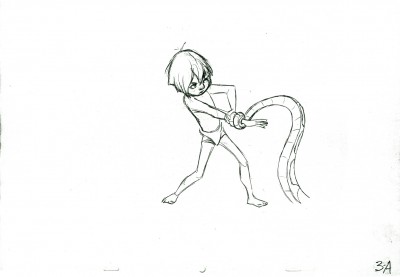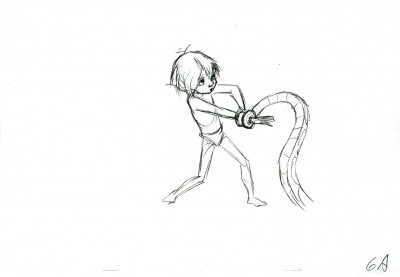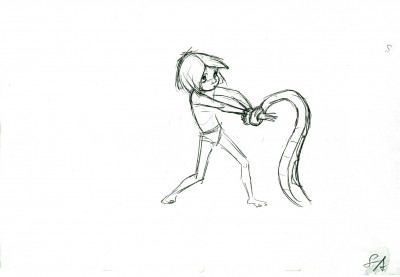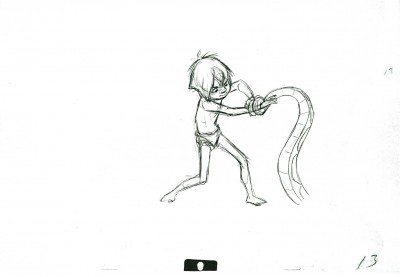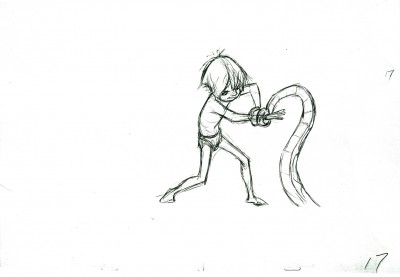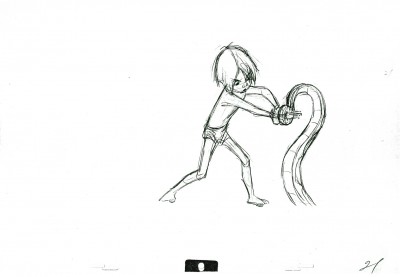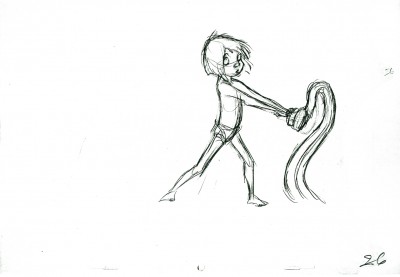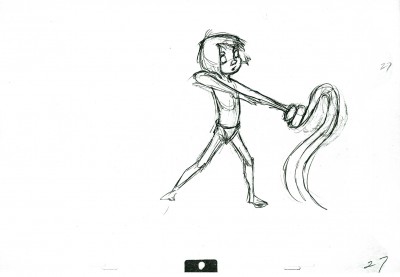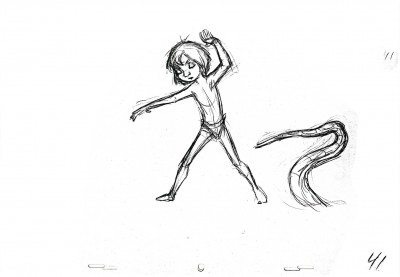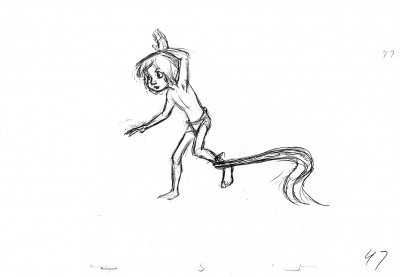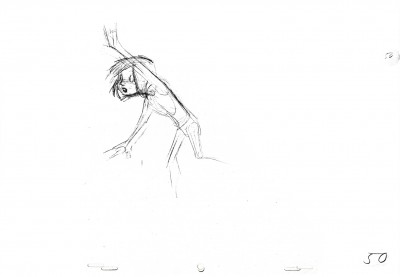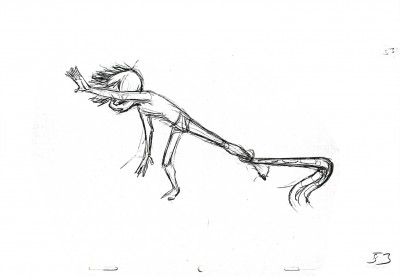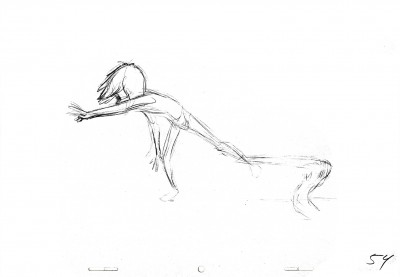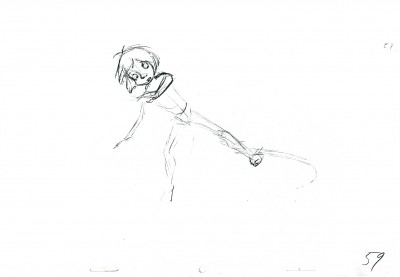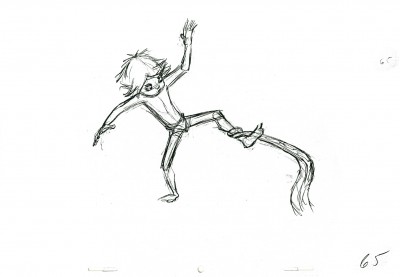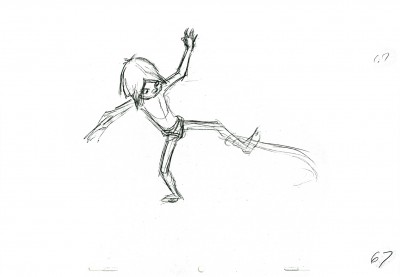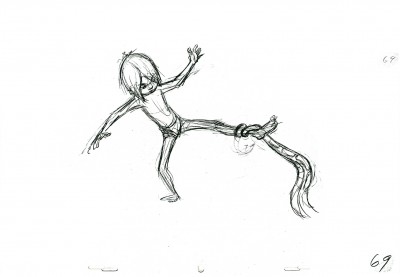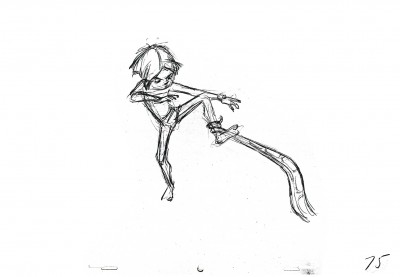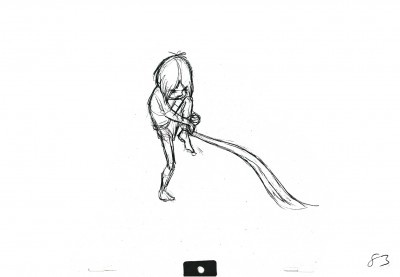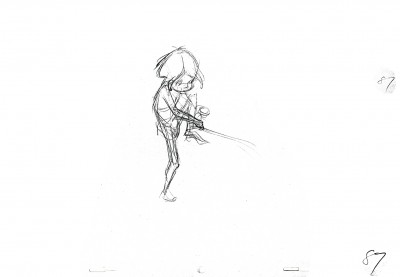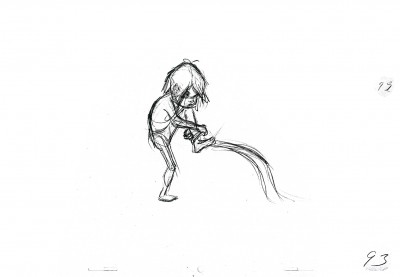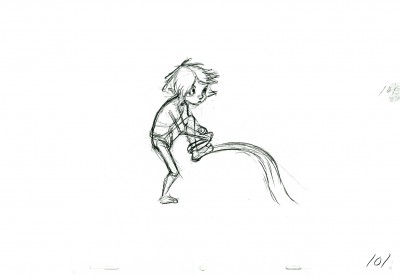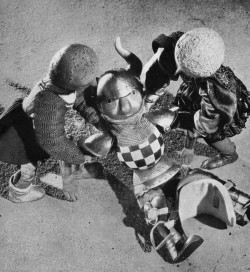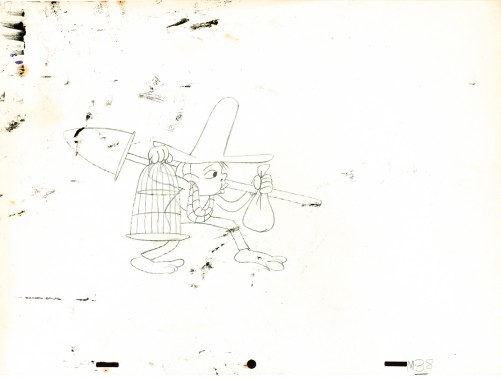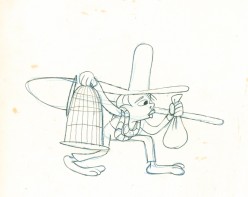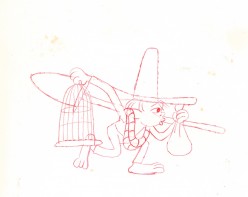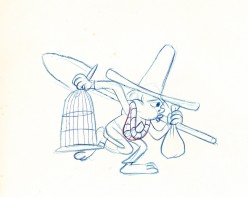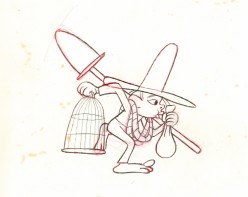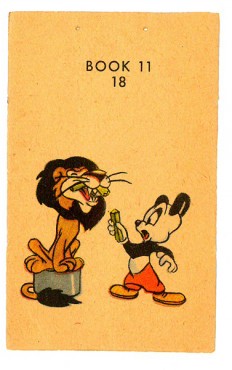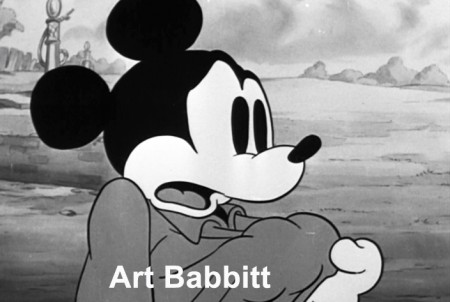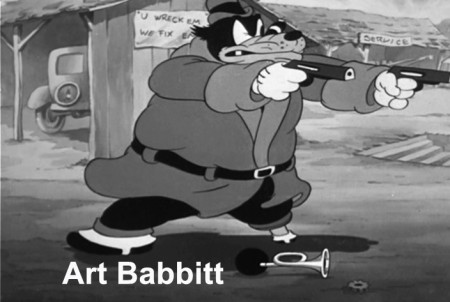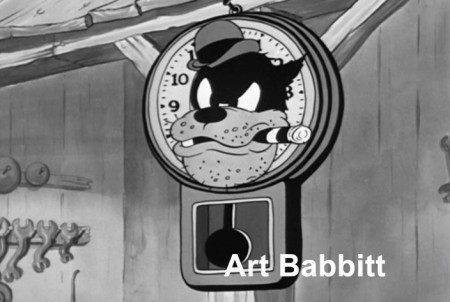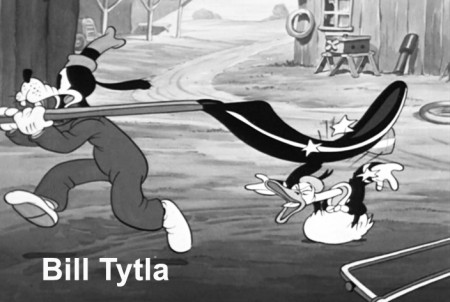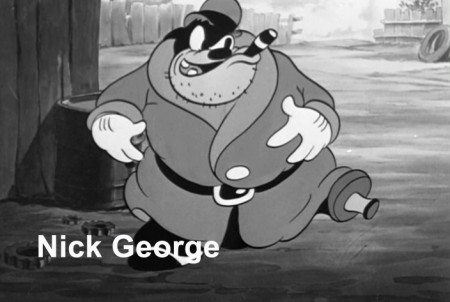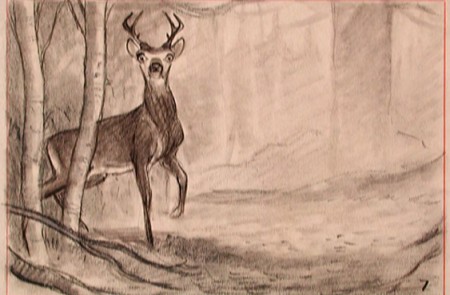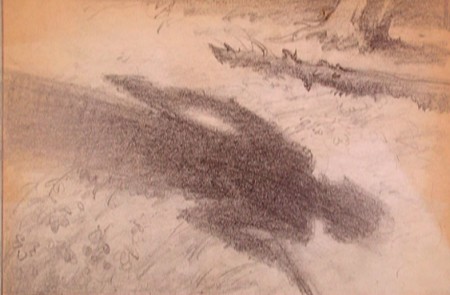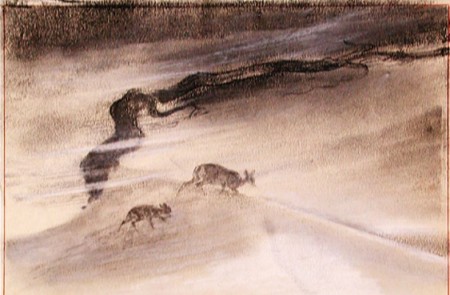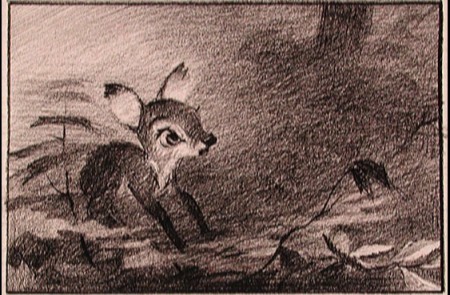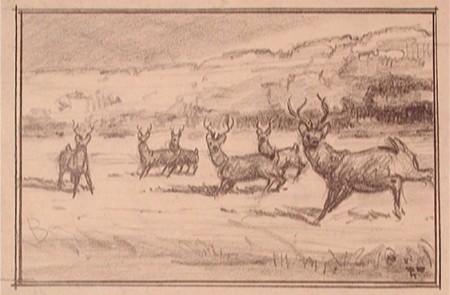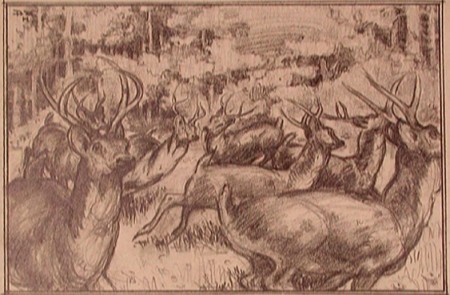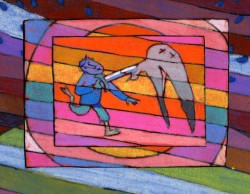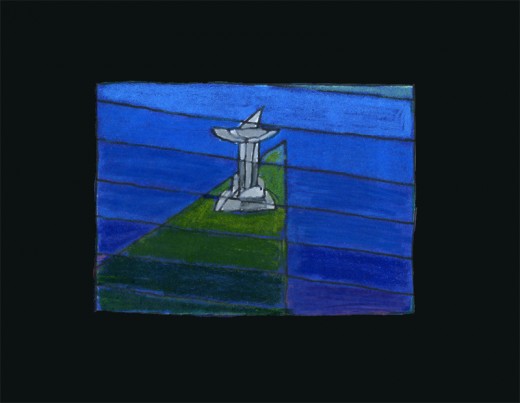Category ArchiveAnimation
Action Analysis &Animation &Animation Artifacts &Disney &John Canemaker 21 Aug 2013 04:54 am
Mowgli & Kaa – repost
Today I’m going to re-post this scene between Mowgli and Kann. It was loaned to me by John Canemaker and stands out like the gem it is. THere are”75 drawings in all, and I’m going to post this whole right here, thoug I’ve put in two short breaks. Enjoy.
I’m not a fan of this film, however, I can’t deny the animation is mostly excellent and sometimes brilliant. Needless to say, Frank Thomas delivered some beautiful work. This scene is a typical example of his work even though it’s not one that calls attention to itself.
In studying the scene you might pay attention to what is on one’s (1-12) as opposed to what is on two’s (13-27) and figure out why.
 2
2(Click any image to enlarge to full animation paper size.)
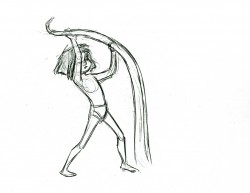 25
25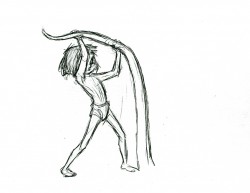 27
27
More to follow next Monday.
Here’s the QT of all the drawings from this scene.
Mowgli & Kaa
Click left side of the black bar to play.
Right side to watch single frame.
Here is another, companion scene with the same two characters. (It comes in the film with only a closeup of Kaa separating the two.)
There are 103 drawings to the scene, so I can’t possibly get them all into the one post. Consequently, I’ll try to do it in three.
Once again, many thanks go to John Canemaker for sharing these on line.
 1a
1a(Click any image to enlarge.)
The Following QT movie is of the complete scene.
I love how he shakes his head and mouths the word “No”
just prior to wrenching his hand from Kaa’s grip.
Right side to watch single frame.
- Last week, I posted the first part of a scene Frank Thomas animated for The Jungle Book. This is the second scene offered that involved the boy, Mowgli, and Kaa, the snake.
This scene follows one I posted several months back. (The two come in the film with only a closeup of Kaa separating them.)
The 103 drawings in the scene will have to be broken into three parts, so you can expect the last third next week.
Once again, many thanks go to John Canemaker for allowing me to share these on line.
I begin with the last of the drawings up last week, #33:
 33
33(Click any image to enlarge.)
The Following QT movie is of the complete scene.
Click left side of the black bar to play.
Right side to watch single frame.
Animation &Books &Commentary &Puppet Animation &Trnka 20 Aug 2013 02:32 pm
Trnka’s “Bayaya” repost
 – Early in the history of this blog, I wrote quite a bit about Jiri Trnka. This man’s artwork has long been a source of great inspiration to me. His illustrations for the fairy tales of Grimm and Andersen are stunning and the two books are of inestimable value to me. His puppet films are so brilliantly strong and lyrically beautiful that I was overwhelmed when I first saw them, even though his reputation preceded them. I’d read enough about him and owned a magnificent biographical account of his work, that I was confident I would be a bit disappointed when I finally saw the films. I wasn’t.
– Early in the history of this blog, I wrote quite a bit about Jiri Trnka. This man’s artwork has long been a source of great inspiration to me. His illustrations for the fairy tales of Grimm and Andersen are stunning and the two books are of inestimable value to me. His puppet films are so brilliantly strong and lyrically beautiful that I was overwhelmed when I first saw them, even though his reputation preceded them. I’d read enough about him and owned a magnificent biographical account of his work, that I was confident I would be a bit disappointed when I finally saw the films. I wasn’t.
The Hand was magnificent and remains one of my favorite films, to this day.
The Archangel Gabriel and Mother Goose is a beautiful animated puppet film about Venice during the late Middle Ages.
The Midsummer Night’s Dream is a feature-length masterwork that has to be seen for any lover of animation – nevermind puppet animation.
 The film, Bayaya was a mystery to me for many years. It was not an easy film to view. Back in the 70s, there was no video, and seeing Trnka’s films meant trips to the NYPublic Library in NY to visit their collection of 16mm films. There you could watch any of the collection or borrow them to watch at home. These films were often littered with many bad splices where the films had broken. The quality of the colors deteriorated over the years. It made for tough viewing, but it also made it possible to see some of the Trnka canon.
The film, Bayaya was a mystery to me for many years. It was not an easy film to view. Back in the 70s, there was no video, and seeing Trnka’s films meant trips to the NYPublic Library in NY to visit their collection of 16mm films. There you could watch any of the collection or borrow them to watch at home. These films were often littered with many bad splices where the films had broken. The quality of the colors deteriorated over the years. It made for tough viewing, but it also made it possible to see some of the Trnka canon.
Bayaya was not part of this collection. In fact, I’ve only seen part of the film once. John Gati, a NY puppet animator who was a good friend, located a copy of a 20 min excerpt (in Czechoslovakian) for an ASIFA-East screening and showed it to a small audience in a classroom at NYU. The print was black and white, but since I’d only seen B&W illustrations, this made sense.
This film represented a strong change for Trnka. He had previously done a number of cel animated films. These shorts were remarkable in that they were a strong step away from the Disney mold. This was a bold step to take in the animation community in Europe circa 1947.
The film was purely lyrical, and the story accented the folk tales quality of these legends of Prince Bayaya and The Magic Sword. Consolidating the two, he named the film after the hero and made him the embodiment of courage, morality and honor.
Trnka considered Bayaya a turning point in his career. He realized that the puppet film had taken on new strength and he had to follow through with every film thereafter.
Here are a couple of scenes from the Trnka book I treasure, Jiri Trnka: Artist & Puppet Master.
There are two parts of a documentary on Trnka available via YouTube. They’re worth the watch. Part 1, Part 2.
Animation &Animation Artifacts &Art Art &Articles on Animation 05 Aug 2013 11:35 pm
King of the Woild

I received an extraordinary award from the The St. Louis Film Festival. This is proof positive that I am the world’s greatest animator. Bill Plympton received the only other one of these awards some three years ago. My current one makes me a true original. (Somehow I ended up as Vincent Price, but I don’t mind so much. It’s an attractive and large – the key word being large = award. When the award makes it to New York, I’ll post it so you can get a look.
Sorry for the delay in some of the new and recent posts. I’m afraid there will be more to come before everything actually gets new.
Action Analysis &Animation &Animation Artifacts &Commentary &Hubley &repeated posts &walk cycle 02 Aug 2013 04:29 am
Marky’s Walk, cycled
 - If I had to choose who was my favorite animator, I’d have a tough time. Equal credit would probably have to go to three different people: Bobe Cannon, Tissa David and Bill Tytla. Jim Tyer and Ed Smith would fall just a smidgen below these three, for me. But there are none like them all, as far as I’m concerned.
- If I had to choose who was my favorite animator, I’d have a tough time. Equal credit would probably have to go to three different people: Bobe Cannon, Tissa David and Bill Tytla. Jim Tyer and Ed Smith would fall just a smidgen below these three, for me. But there are none like them all, as far as I’m concerned.
I’ve posted a lot of drawings from Tissa and Bill Tytla, but have very few drawings by Bobe Cannon (nor have I seen many published anywhere.)
 Here is a walk cycle from the beginning of Hubley’s monumental short, Moonbird. The odd numbers are extremes by Cannon, and the inbetweens (even numbers) were done by Ed Smith. Three different sized papers were used for this, and you can view them full sized if you click the thumbnails.
Here is a walk cycle from the beginning of Hubley’s monumental short, Moonbird. The odd numbers are extremes by Cannon, and the inbetweens (even numbers) were done by Ed Smith. Three different sized papers were used for this, and you can view them full sized if you click the thumbnails.
You’ll notice there’s paint all over the drawings. The ink & paint involved tracing the drawing, then using oil paints to cover all of the clear area in black. Some of that paint seeped onto the originals. In one drawing even to coloring the hat accidentally.
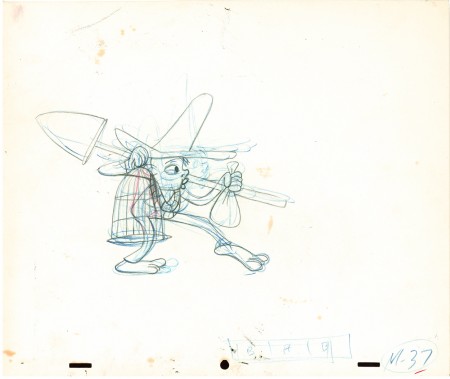 37
37(Click any image to enlarge.) “Marky” walk cycle from Moonbird
On twos at 24FPS
Click left side of the black bar to play.
Right side to watch single frame.
There’s a lot more to this scene including several variants on the walk.
At some future time, I’ll add the other drawings to show off the entire scene.
Action Analysis &Animation &Frame Grabs 29 Jul 2013 11:16 am
Andy Panda & Oswald Rabbit Flipbooks
- Imagine you’re a kid in 1949 eating your Grape Nuts Flakes in the morning. You’re about to pour on the milk when you realize you’ve found the Flipbook that was included in the box. Would that start you on your way of wanting to become an animator? Would you just flip it and throw it out?
Back then the Walter Lantz studio had a promotion going where they gave a number of flipbooks free to consumers of the Post cereal.
The pages were double-sided. This side features Oswald the Rabbit blowing up his tire. The flip side has Andy Panda. Andy is in full color, whereas Oswald was just line work, so you know which one was still a “star” in 1949.
The registration wasn’t very good on the printed page, and I had to adjust a bit to make it work. The paper it was printed on is newsprint and delicate. The images in the thumbnail are about twice the size of the original.
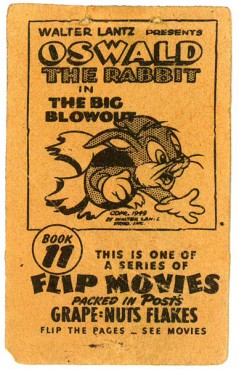 1
1 
(Click any image to enlarge.)
 3
3  4
4
The following QT movie is exposed on 3′s to make the action work.
Click left side of the black bar to play.Right side to watch single frame.
- Then I posted the other side of this flipbook. In 1949, the Walter Lantz studio had a promotion going where they gave a number of flipbooks free to consumers of Grape Nuts Flakes.
The pages were double-sided. This side features Andy Panda taming a lion. Andy is in full color, whereas the flip side – Oswald – was just line work, so you know which one was still a “star” in 1949. See the Oswald book here.
The registration wasn’t very good on the printed page, and I had to adjust a bit to make it work. The paper it was printed on is newsprint and the color registration is also off. The images in the thumbnail are about twice the size of the original.
 1
1  2
2(Click any image to enlarge.)
“>
 3
3  4
4
“>
 5
5  6
6
“>
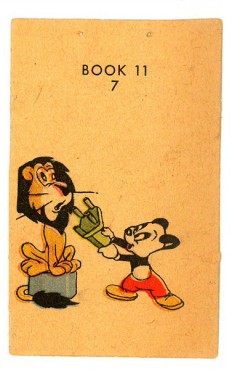 7
7  8
8
“>
 9
9  10
10
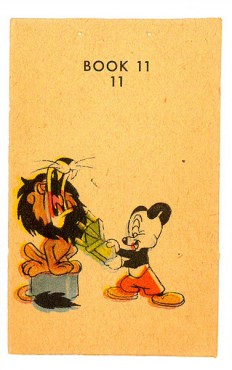 11
11  12
12
The drawings of the following QT movie were exposed
on threes to best make the action work.
Right side to watch single frame.
Animation &Commentary &Independent Animation 22 Jul 2013 04:25 am
A Friend in Lou
- I’ve been thinking a lot about my friend, Lou Scarborough, this past week. So why not write about him? That’s what I’m going to do. Just random thoughts, good and bad, I guess. All just random. I’m sure I’ll have other posts to add to this, eventually.
I met Lou years ago the same way I met a whole core of NY friends and folk.
 Back in 1978, Disney celebrated the 50th anniversary of Mickey Mouse’s creation. History for a lot of us – I mean, here, the celebration not the creation. The MoMA had a retrospective of all 50 years of Mickey cartoons in chronological order. They started with a bunch of silent Alice in Cartoonland followed by Oswald the Rabbit cartoons. They were shown silent. I mean SILENT – no audio, not even an organ. They ended that first program with Steamboat Willie. Now there was the invention of sound. You could hear it, you could feel it, you knew a new era had begun. Soundies.
Back in 1978, Disney celebrated the 50th anniversary of Mickey Mouse’s creation. History for a lot of us – I mean, here, the celebration not the creation. The MoMA had a retrospective of all 50 years of Mickey cartoons in chronological order. They started with a bunch of silent Alice in Cartoonland followed by Oswald the Rabbit cartoons. They were shown silent. I mean SILENT – no audio, not even an organ. They ended that first program with Steamboat Willie. Now there was the invention of sound. You could hear it, you could feel it, you knew a new era had begun. Soundies.
Up at Lincoln Center, they were showing all the feature films, animated as well as live action films. Things like Pollyanna and Treasure Island as well as Lady and the Tramp and Dumbo.
The best part, though, was around the corner, daily, at the Library of the Performing Arts. Speaker/Guests included Animators: Frank Thomas, Ollie Johnston, Woolie Reitherman, Designer: Eric Anderson, and John Culhane moderated a bunch of it. They showed clips of a lot of the feature animated films; they told famous stories for the millionth time, they told stories we hadn’t heard before. (e.g. Reitherman wanted the disco ball and the changing colors as the cats of the Aristocats played jazz in the attic. His was not something others wanted in the film. The director got what he wanted including a lot of reuse animation. Reitherman learned something about Xerography other than inking stories during 101 Dalmatians.
Anyway, to get into this series of programs (I’m sure there were four of them) you’d sit on the ground in the hot sun waiting for the doors to open when they handed out tickets. I was working for John Hubley at the time. A lot of the others: Dan Haskett, Tom Sito, Pat Sito, John Lopez, Kevin Petrilak, Bob Lusk, and, of course, Lou Scarborough, all worked at a place called Tele-Tactics where they were paid horrible wages as animators working on something called The Days of Liberty.
Over time, a lot of those people went to Raggedy Ann in a direct route uptown once that studio opened. I was teh first hired there, so I got to watch the influx as animation began.

Lou went with a whole group directly into the Taffy Pit to clean up and inbetween the elaborate and gutsy drawings of the master, Emery Hawkins. Exhausting work but they were all friends and had a group all their own during Raggedy’s world. A new era of sorts had begun – the taffy pit folk. Ultimately, they all moved out to LA, worked at Disney for a bit and at a bunch of other feature studios for a bit.
- I also remember during the late 70′s and early 80′s that Lou Scarborough was closely involved with Wendy and Richard Pini‘s fantasy characters from Elf Quest.


A sample of the Elf Quest art
Along with Dan Haskett and other friends he helped build model sheets and tried desperately to get the comic books animated. I don’t believe much happened with the work, especially after it moved to cgi. In my opinion it lost any magic it had in the 2D cartoon drawings and completely lost everything in the clumsy cgi artwork.
In a way, it seems to me that this art style seriously affected Lou. Though I was certainly not a fan, I did appreciate the hard work all the artists did in putting it together. The whole enterprise, though, seemed like too many other fantasy pieces that were out there.
Lou was one of the last to leave New York City for the West Coast. He did a couple of jobs for me before he left. There were some Sesame Street spots, dances, that he animated. Then there were a couple of episodes of a show called Brain Games done before Sheila Nevins moved in and took over at HBO. I did about 45 minutes of the six half hour shows Sheila produced with Jeff Schon as co-producer. . It was all fun work. Lou animated a centurian and oddly he had the guy move wildly from the forth pose to the fifth. There was an enormous surprise when this character moved, so traditionally drawn, and moved beautifully. The large
 arc worked for the character and found me imitating Lou’s move more than once in future scenes. A peculiar layout that worked so well. I was the only one who noticed it and the only one who worried about it. No problema, it worked.
arc worked for the character and found me imitating Lou’s move more than once in future scenes. A peculiar layout that worked so well. I was the only one who noticed it and the only one who worried about it. No problema, it worked.
Lou moved to LA and worked on various business out there. He did a number of MGM musicals for home video. Things like Babes in Toyland, The Quest for Camelot, as well as The Adventures of Sonic the Hedgehog.
In the end, Lou ended up without money but still a lot of dreams. Now he’s fighting cancer in a hospital at a young age. Life’s tough, and I’m watching my friend closely. I hope his luck gives him a couple of good breaks.
Action Analysis &Animation &Animation Artifacts &Commentary &Disney &Frame Grabs 15 Jul 2013 06:40 am
Mickey’s Service Station Grabs
- Having posted sketches from Mickey’s Service Station, the brilliant 1935 short, the last B&W Mickey film, the next thing for me to do, logically, is post frame grabs from the final film – for comparison.
Since Hans Perk has made available the film’s draft on his incredibly resourceful site, AFilmLA, I’ve also added the animators’ names to the frame grabs. What an assortment it is, too. Art Babbitt, Eric Larsen, Bill Tytla, Jack Kinney, Don Towsley, Fred Spencer, Milt Kahl, Ferdinand Hovarth, Archie Robins among others.
Here, then, are the scenes from the film:
 1
1(Click any image to enlarge.)
Action Analysis &Animation &Articles on Animation &Commentary 07 Jul 2013 05:00 am
Two Tier Tyre
 – Somehow always touching in the back corners of the recesses of my mind is the work of Jim Tyer. He’s possibly the most well-known animator in the medium’s short history. The guy has done such eccentric work that it’s impossible to find someone comparable. Even to those who don’t realize they’re mimicking his work, they would be surprised to learn that they’re doing Jim Tyre and not Tex Avery or Bob Clampett and Rod Scribner.
– Somehow always touching in the back corners of the recesses of my mind is the work of Jim Tyer. He’s possibly the most well-known animator in the medium’s short history. The guy has done such eccentric work that it’s impossible to find someone comparable. Even to those who don’t realize they’re mimicking his work, they would be surprised to learn that they’re doing Jim Tyre and not Tex Avery or Bob Clampett and Rod Scribner.
A number of things have been written about Jim Tyer. Interestingly, it’s predominantly the same few people that seem to be writing and usually the same bits are repeated.
Chief among sites that offers bits and comics among their offerings, is Kevin Langley‘s Cartoons Comics and Model Sheets. This blog first caught my attention with plenty of Mr. Tyer’s imaginative drawing. Not quite rough, not quite gesture drawing, and certainly not rendering. The best one could say was Wacko.
You see I’d been an ardent enthusiast of Mr. Tyer’s work for years, and here they were – stills. Plenty of them. So there were lots and lots of links. You can’t really write lots of words when processing Jim Tyer’s material. As a matter of fact, I can only think of one pwerson who did that job and did an impeccable turn of it. Mark Mayerson.
As a matter of fact, you might want to stop reading here and go to Mark’s comments, now. He had two key things to say and no one else has had much more to say to me. It’s a paper he wrote in 1990 and with it he had more to say about Jim Tyer‘s work than had anyone else to that date.
I meant for this piece to be much more exhaustive, but the problems I’m having with my internet are annoying. Unfinished pieces have been thrown up as complete. This is one of them, the Provenson piece (though that’s much more finished) made it to post, and others as well. I may quit writing at all until Verizon finally comes to my door to correct my phone service. (I still don’t have an operating phone number after three weeks and my internet is intermittently up and down based on its own whim.)
I apologize for the sloppiness of the whole thing.
Animation &Animation Artifacts &Articles on Animation &Disney &Illustration &Models &repeated posts 29 Jun 2013 03:51 am
Young Bambi – repost
- It all starts with a drawing.
The brilliant host of cartoonists that came before us were an amazing group. To think of the complicated set of characters that the created. Characters with complex personalities and sophisticated drawing techniques.
Those characters went trough the mill in my own life time. Seeing the horrendous things that have happened not only to Mickey, Donald and Goofy but to Bugs, and Daffy and other Warner’s Bros characters. It’s been shameful.
I was going to post illustrations of some of those bastardizations, but I think it’s enough just to mention some of them.
Think of the Mickey Mouse Clubhouse running now on the Disney Channel. If ever there was proof positive that cgi weren’t cartooning, that would be it. Those are very unsophisticated digital puppetry shows where every move is obvious and preplanned, the voices are hideous, and the stories nowhere sophisticated enough to call trite.
Take a quick jump from those to the flash animated whirls that are being released with a lot of fanfare, and you’ll see what can go wrong with animation of stars. They may as well have dug Marilyn Monroe and Clark Gable out of the ground to allow the computers to move them as well. Like all new animation that’s being called good, these beasts-of-films are moved at the speed of light where no move gets to have any personality. Think of that naked Mickey in the most recent release. A thin slime of a creature, all black, that looks like a clam being animated by a Jim Tyer. There isn’t a pose in the film that could compare with what Terrytoons did – Terrytoons, the bottom of the barrel. They had personality all over these poorly drawn efforts.
There were the old Greg Ford versions of the WB characters for theatrical release, compilations of old with new. They were all mediocre but had the honor of the past directors in mind. The Bakshi Mighty Mouse cartoons were a take on their group of characters, but you had someone with a personality, Bakshi, trying to do wonders with a library of “B” stars. Even with the TV budgets, they were trying hard to do something, and often they were successful.
Today it’s all for poor exploitation, and no one is trying to do wonders with their characters. It’s all too sad.
The WB characters have had even greater attempts at poor art. You don’t have to think back too far to remember the sitcom version of the characters now running on Cartoon Network, also done in Flash. Think back to the poorly designed wretches that WB issued to their local network of stations, the WB. Those poor animated creatures were redesigned versions with scales and all. It’s just about time to scream, “Enough!” Is there not one executive who can offer some honor to these golden characters of our past? How much do we have to watch?
Why did these studios create their archives? Was it just to resell the goodies or was anything preserved so that the future animators could do right by these characters?
- It all starts with a drawing.
That’s all I can think. With that I’m just going to post a number of gems from Bambi. These had to have had some purpose greater than feeding Bambi !!. Or maybe I’m wrong.
Bambi is, to me, one of the most beautiful of animated features. Collectively, the artists at the Disney studio pulled together to create some wonderful artwork which produced a wonderful film.
The initial work went through many phases, as would be a natural state for animation. However, all of the artists seem to be trying for a higher plane, and oftentime they reached it.
To celebrate the latest release of this film, the Blu-Ray/DVD version, I’ve pulled a lot of the drawings from the film and post them here. It’s amazing how much influence Marc Davis had early on. I can only ID the artists of some of the sketches. If you know, let me know. We have to continue to ID these artists. Without their names we just have these flash animatedMickes that don’t even include one credit. And maybe they shouldn’t be credited; the work is so embarrassing.
 1
1David Hall
 3
3
(above and below) Marc Davis
 7
7
(above and below) Ken Peterson
Animation &Animation Artifacts &Books &Comic Art &Layout & Design &SpornFilms &Story & Storyboards 28 Jun 2013 05:40 am
Jabberwock – repost
- To me, Lewis Carroll‘s nonsense poem, Jabberwocky, is one of the most brilliant pieces ever written. It’s always been important to me, and I’ve collected many versions of it in illustrated versions. Now that I mention it, let me confess that I’m a Lewis Carroll addict, and Jabberwocky is one of my favorites among his many poems.
In film, you have the one live action feature by Terry Gilliam; it’s a good film with a clunky monster in the end. In animation, professionally, I know of only two versions completed. One was by Jan Svankmajer done in 1974. I did a version of it in 1989. Mine, of course, sticks closer to the poem even though it is pretty “arty”.
 Apparently, there was also a version Disney was preparing as part of Alice In Wonderland. A book was published, credited to the “Disney Archives,” with illustrations from the preparatory drawings of this sequence. It’s obvious that the final versions of these drawings were done by one person, but there’s no record in the book of who did the finals. I’d read somewhere that Marc Davis had a lot to do with it, at one point. Though he obviously was most involved with Alice, herself.
Apparently, there was also a version Disney was preparing as part of Alice In Wonderland. A book was published, credited to the “Disney Archives,” with illustrations from the preparatory drawings of this sequence. It’s obvious that the final versions of these drawings were done by one person, but there’s no record in the book of who did the finals. I’d read somewhere that Marc Davis had a lot to do with it, at one point. Though he obviously was most involved with Alice, herself.
I’m not in love with the images in the book. I like the technique used, but I find the images too cute. Though, it’s amazing how current they look.
(Click on any image to enlarge.)
I’m going to give you a number of the book’s pages today and, in comparison, will follow it up with images from my version tomorrow.

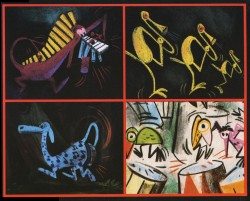
‘Twas brillig and the slithy toves
Did gyre and gimble in the wabe;


All mimsy were the borogoves,
And the mome raths outgrabe.


“Beware the Jabberwock, my son!
The jaws that bite, the claws that catch!”
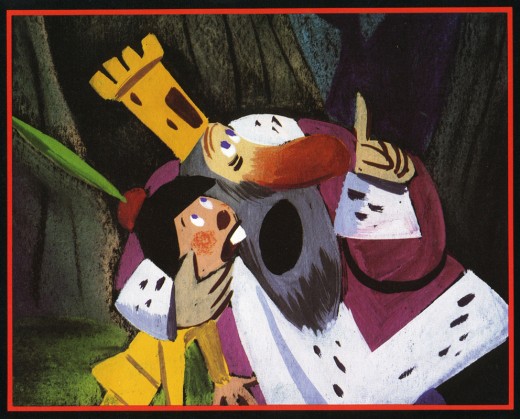
“Beware the Jubjub bird, and shun
The frumious Bandersnatch!”


He took his vorpal sword in hand;
Long time the manxome foe he sought -
So rested he by the Tumtum tree
And stood awhile in thought.


And as in uffish thought he stood,
The Jabberwock, with eyes of flame,
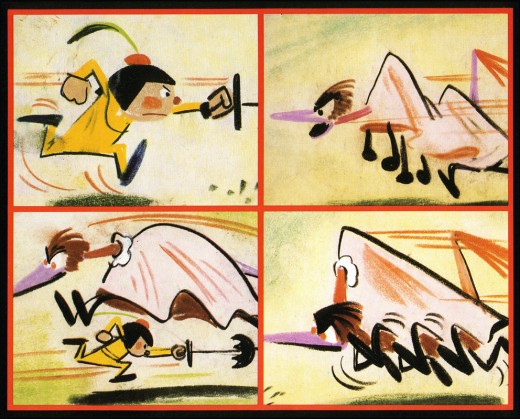
Came whiffling through the tulgey wood,
And burbled as it came!


One, two! One, two! And through and through
The vorpal blade went snicker-snack!


He left it dead, and with its head
He went galumphing back.

“And hast thou slain the Jabberwock?
Come to my arms, my beamish boy!
O frabjous day! Callooh! Callay!”
He chortled in his joy.
Jim Hill talks a bit about this book on his site in a letter response. here.
For amusement, you might check out this site for translations of this poem into 58 other languages, 23 parodies of the poem, and 10 explanations trying to define what Carroll meant by it.
I’d like to post here a few of the images from my short adaptation of the Lewis Carroll poem, Jabberwocky. In doing the film, I tried to mimic a style I’d used in my oil paintings and felt it was a bit successful. I don’t think the filmed version is all it could be – it was rushed to complete a package which included the 19 min. film, The Hunting of the Snark, as well as an animated documentary done about Lewis Carroll’s nonsense poems. Of course, the video package wouldn’t have made sense without including Jabberwocky.

(click any image to enlarge.)
But I’ve scanned these images from the actual artwork and realize how well they’ve held up. I’d like to redo the film digitally someday and see where I can go with it.
Here are some of the images:


‘Twas brillig and the slithy toves,
Did gyre and gimble in the wabe;
All mimsy were the borogoves,
And the mome raths outgrabe.
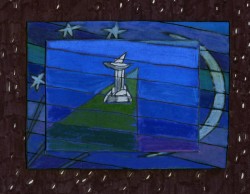

“Beware the Jabberwock, my son!
The jaws that bite, the claws that catch!â€

“Beware the Jubjub bird, and shun
The frumious Bandersnatch!â€


He took his vorpal sword in hand;
Long time the manxome foe he sought -

So rested he by the Tumtum tree
And stood awhile in thought.


And as in uffish thought he stood,
The Jabberwock, with eyes of flame,

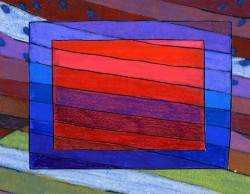
Came whiffling through the tulgey wood,
And burbled as it came!


One, two! One, two! And through and through

The vorpal blade went snicker-snack!

He left it dead, and with its head
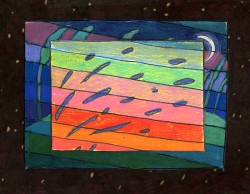
“And hast thou slain the Jabberwock?
Come to my arms, my beamish boy!
O frabjous day! Callooh! Callay!â€
He chortled in his joy.
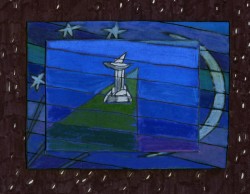

‘Twas brillig and the slithy toves
Did gyre and gimble in the wabe;












